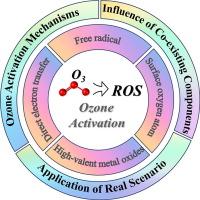Impact of coexisting components on the catalytic ozonation of emerging contaminants in wastewater
IF 8.1
1区 工程技术
Q1 ENGINEERING, CHEMICAL
引用次数: 0
Abstract
Catalytic ozonation, a promising advanced oxidation process (AOP), leverages catalysts to activate ozone (O3) into highly reactive oxygen species (ROS) like hydroxyl (HO•) and superoxide radicals (O2•-). These potent oxidants effectively degrade refractory organic pollutants in wastewater. Nevertheless, the presence of complex coexisting ions and organic compounds in real wastewater can significantly hinder the removal efficiency of target pollutants during catalytic ozonation. Consequently, a thorough understanding of how coexisting ions and organics influence the catalytic ozonation process is crucial for optimizing its effectiveness in wastewater treatment. This review delves into the degradation pathways of emerging contaminants (ECs) during catalytic ozonation, considering the influence of these coexisting components. By analyzing interfacial reactions involving catalysts, O3, and coexisting components, this review aims to elucidate the underlying mechanisms and propose strategies to optimize the performance of catalytic ozonation for real wastewater treatment.

求助全文
约1分钟内获得全文
求助全文
来源期刊

Separation and Purification Technology
工程技术-工程:化工
CiteScore
14.00
自引率
12.80%
发文量
2347
审稿时长
43 days
期刊介绍:
Separation and Purification Technology is a premier journal committed to sharing innovative methods for separation and purification in chemical and environmental engineering, encompassing both homogeneous solutions and heterogeneous mixtures. Our scope includes the separation and/or purification of liquids, vapors, and gases, as well as carbon capture and separation techniques. However, it's important to note that methods solely intended for analytical purposes are not within the scope of the journal. Additionally, disciplines such as soil science, polymer science, and metallurgy fall outside the purview of Separation and Purification Technology. Join us in advancing the field of separation and purification methods for sustainable solutions in chemical and environmental engineering.
 求助内容:
求助内容: 应助结果提醒方式:
应助结果提醒方式:


